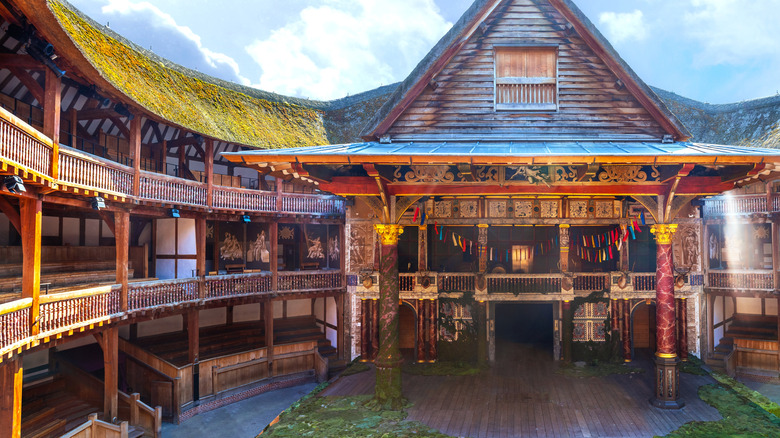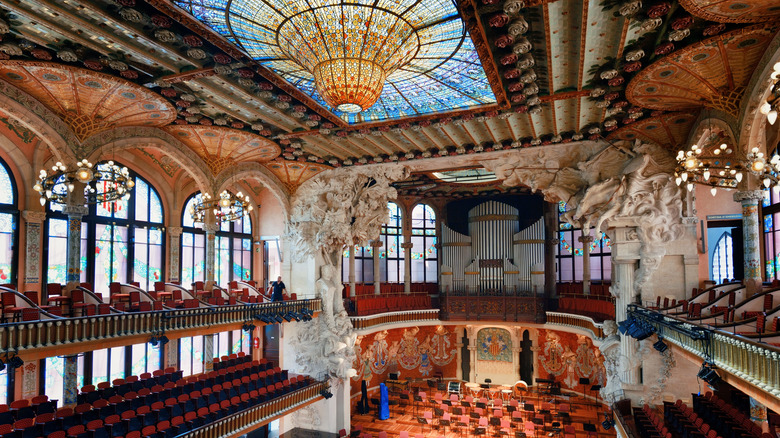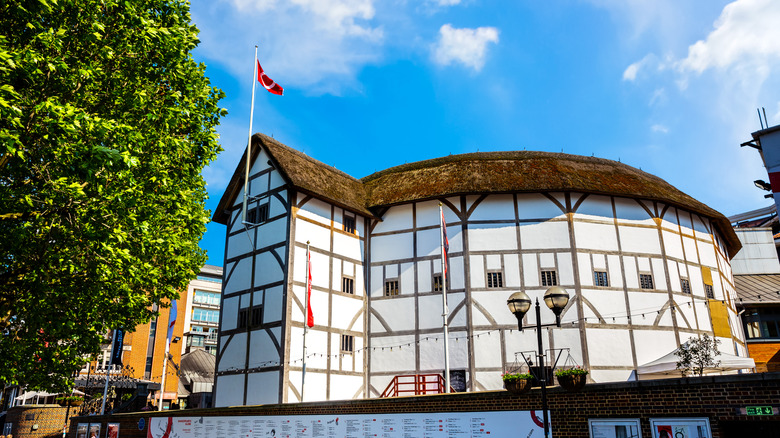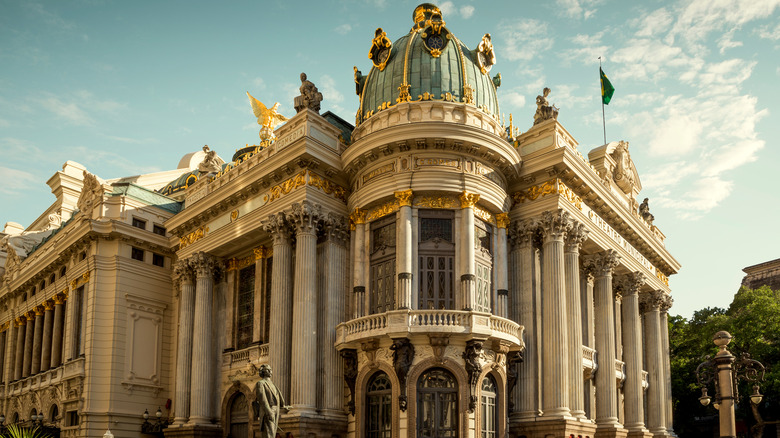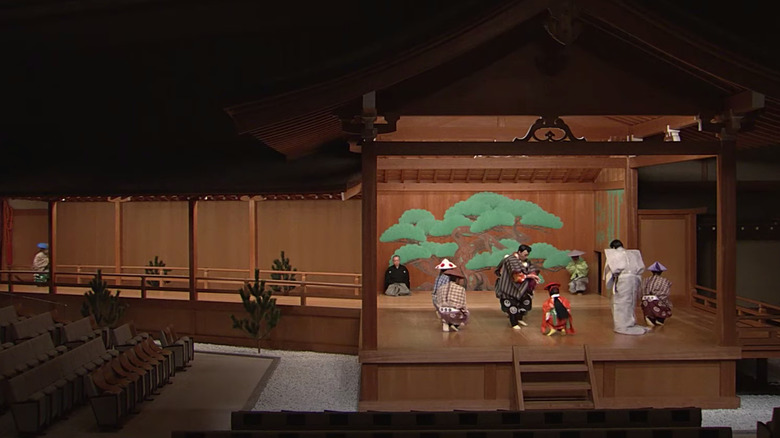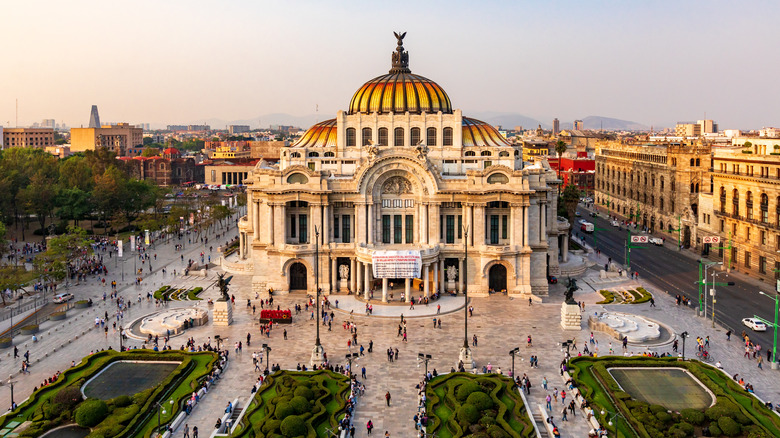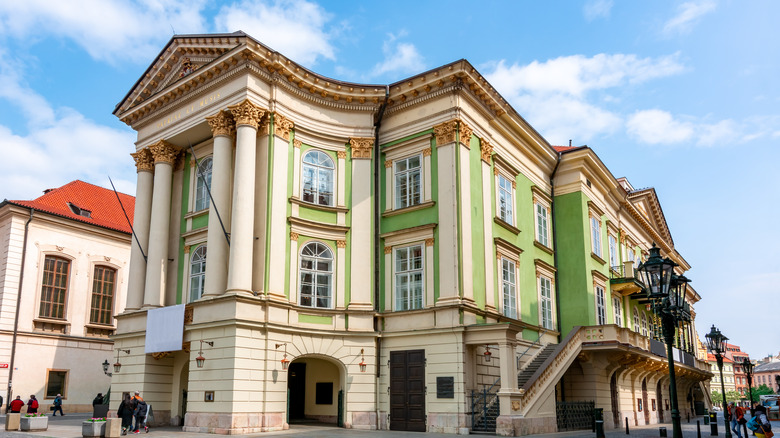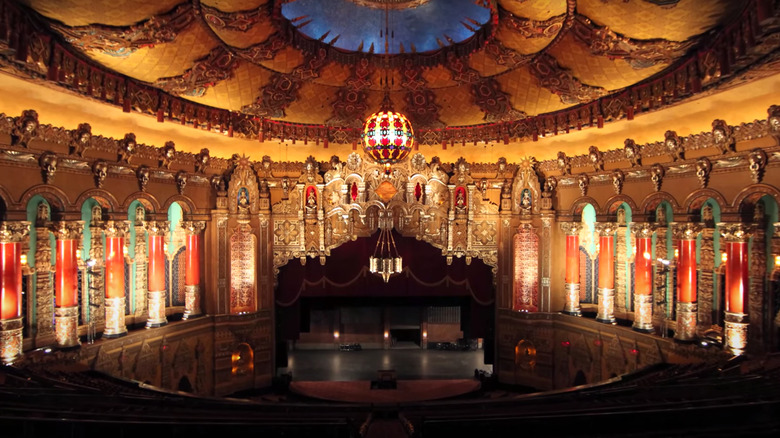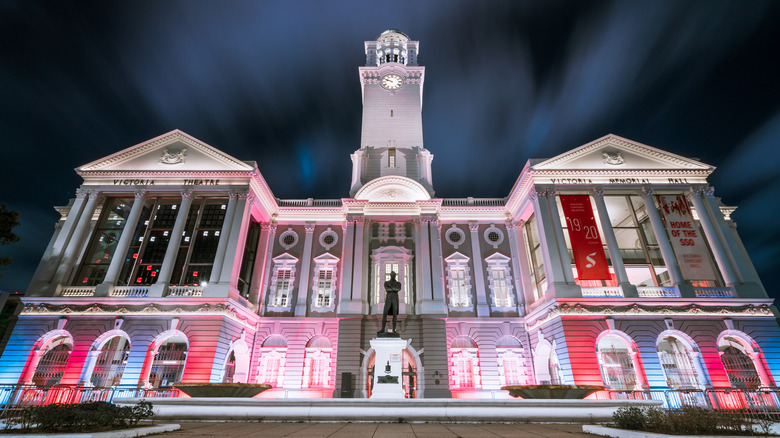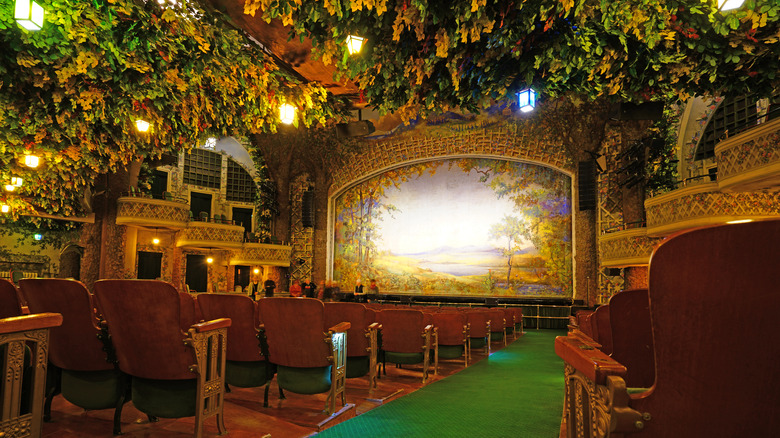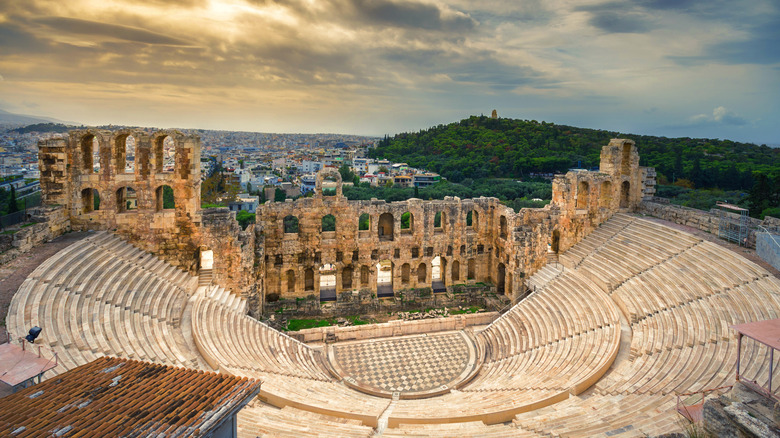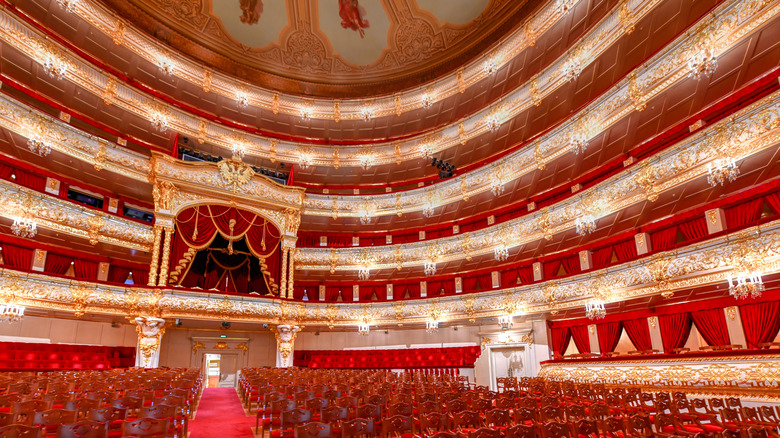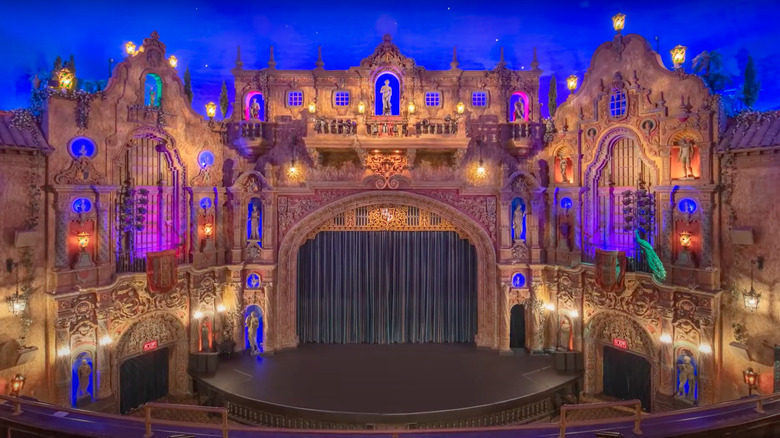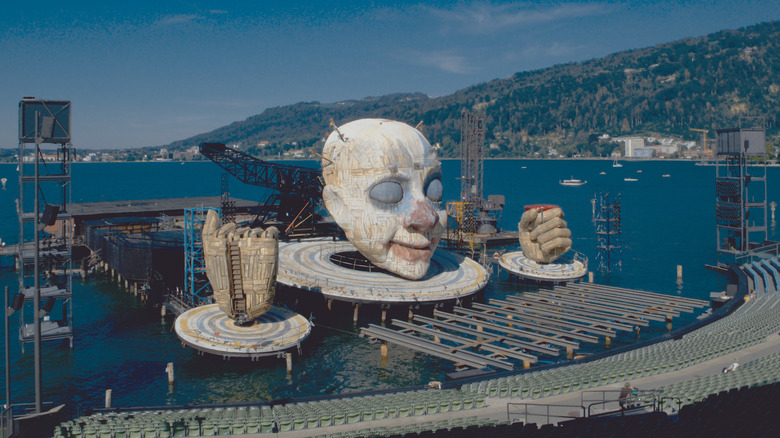The Most Stunning Theaters Around The World
You don't have to be a theater lover to appreciate the innate beauty of the buildings where these performances take place. The world's most beautiful playhouses, opera houses, and stages all have their own distinct character, including stand-out architecture, sumptuous materials, and rich history. They often date back hundreds of years or serve as an important symbol of the city around them. Per What's On Stage, there really are some theaters that you step into and never forget.
Often, the design of the theater is just as important as the live performance itself when it comes to audience experience. A grand theater has the power to take viewers to a different time or place in an instant, becoming a part of the magic. To celebrate these majestic stages, we are counting down the most stunning theaters around the globe. These stages are always worth seeing, whether you're visiting for a performance or simply stepping inside to take a look around.
Palau de la Musica is a stunning example of Modernisme style
Stepping inside the Palau de la Musica is like witnessing magic. This ornate concert hall in Barcelona is a masterpiece of Modernisme, mixing different art forms such as sculpture and columns decorated with mosaics, as well as architectural styles. The building was designed by Lluís Domènech i Montaner and built between the years 1905 and 1908 to provide a home for the Orfeó Català choir, a popular music club in Barcelona at the time. According to Tourist Guide Barcelona, locals are proud of the unique theater and see it as symbol of the city's open-minded spirit.
Inside the concert hall, colorful glass windows, an arched ceiling dome, and sculptures of 16 muses representing different countries vie for one's attention. An organ rests above the main stage, while two statues, representing classical and folk music, frame either side. Whether visiting for a musical performance or just to take in the sights on one of the guided tours, this beautiful theater is designed to delight.
Shakespeare's Globe is built in the same style as the 16th century original
While Shakespeare once wrote that "All the world's a stage," nowhere is this more true than at his Globe theatre. This world-renowned venue has been hosting Shakespeare's plays since the 16th century. While the theater has been moved and rebuilt over the years, the current version is as close to the original as possible. According to the Shakespeare Birthplace Trust, a team of historians, architects, and literary scholars collaborated to recreate the theater in the same style as the first Globe. They included the thatched roof, green oak construction, open-air design, and secured the timbers with wooden pegs using the same methods as carpenters from the 16th century. The main differences are that they had to line the roof with fire-retardant material and add emergency exits and doors in case of a fire. After all, the original theater was burned when a cannon filled with gunpowder set the roof on fire during a performance of "Henry VIII." In just over an hour, the entire playhouse was destroyed.
The current Globe, which is the third version, is located on the banks of the River Thames in London, just one street away from where Shakespeare and his acting company, The Chamberlain's Men, originally performed. Today a variety of Shakespeare's classic plays are performed, along with contemporary pieces each season.
The design of the Municipal Theater of Rio de Janeiro was inspired by the Palais Garnier in France
Luxurious inside and out, the Municipal Theater of Rio de Janeiro is one of Brazil's most important theaters. This grand building was constructed at the beginning of the 20th century and was designed to update the city with a modern home for theater, as noted by Culture Trip. Many different artists collaborated to complete the structure, which took over four years to finish. The result is an exterior inspired by the Palais Garnier in France and many masterful works of art grace the interiors.
Today, the walls of the façade feature gold detailing and the names of renowned Brazilian artists, as well as other leading European figures. Inside the main auditorium, there is a beautiful painted curtain from Eliseu Visconti, an Italian artist, and sculptures by the Bernardelli brothers. During the theater's early years, the performances were primarily French and Italian operas, while the present program mainly includes ballet and classical music.
National Noh Theatre features a 400-year-old stage
Located right in the heart of futuristic Tokyo, the National Noh Theatre feels a world away from the city's dazzling lights, sleek skyscrapers, and chic city apartments. Named an Intangible Cultural Property by UNESCO, the theater is notable for its traditional craftsmanship and artistry. It was built in 1983, although the main stage is over 400 years old and made from cypress wood, per Backpacker Travel.
Performances take place at the National Noh Theatre all year long, including kyogen and noh, which are historic Japanese musical dramas that tell stories using elaborate wooden masks and hand gestures. Actors in noh plays are not characters, but instead become narrators who tell the stories. Noh has been around for over 1,000 years and the performances have changed little over time, thanks to their strong emphasis on tradition. In the theater, every seat is equipped with English subtitles on monitors so that people from all over the world can experience this unique art form.
The Palacio de Bellas Artes is decorated with paintings from world-famous artists
Nicknamed the "Cathedral of Art in Mexico," the Palacio de Bellas Artes beckons from its prominent position in Mexico City's historic center. The theater features stunning white-marble construction and an iron and crystal roof, as well as a number of other priceless treasures within its walls, as noted by the World Monuments Fund. Construction first began in 1905, but was delayed due to the Mexican Revolution and structural problems after the building's dense marble shell sank into the subsoil. Eventually it was completed in 1934, with an art nouveau exterior and art deco interior.
Inside, Culture Trip notes that a spectacular array of murals from world-famous artists awaits, including pieces from Zapotec painter Rufino Tamayo and Diego Rivera's iconic "El hombre en el cruce de caminos" (Man at the Crossroads). While the painting was first created to hang in Rockefeller Center in New York City, the building's industrialist owners destroyed it due to capitalist themes. Rivera recreated it for the Palacio de Bellas Artes, where it has lived ever since. Over the years, the grand building has hosted a variety of noteworthy opera, music, and dance performances.
The Estates Theatre is known for its connection to Mozart
Prague's Estates Theatre was built with the best of intentions. In 1781, Aristocrat František Antonín Count Nostitz Rieneck wanted to raise the cultural level of his city and inhabitants by building a theater accessible for all, in keeping with the spirit of the 18th century. In just two years, the Neoclassical theater was up and running with the motto "Patriae et Musis" (To the Homeland and the Muses) written above its front entrance. While Italian and German operas were mainly performed during the theater's early years, the first Czech language performances also took place here.
One of the most important elements of the Estates Theatre history is its connection to Wolfgang Amadeus Mozart, who held the world premiere of his opera "Don Giovanni" here in 1787. Today, the theater is the only venue still in operation where a Mozart opera premiered with the composer himself conducting, per the National Theatre. The theater's current program continues to focus on Mozart's work.
The Fox Theatre is known as Detroit's crown jewel
Originally built by movie palace mogul William Fox in 1928, the Fox Theatre has a long history of welcoming audiences into its large, brass doors. At the time it was constructed, the Fox was the second largest theater in the world and featured state-of-the-art sound equipment for talking movies, or "talkies," as they were referred to at the time. Architect Charles Howard Crane oversaw the design, while Fox's wife, Eve Leo, styled the main auditorium with Egyptian, Indian and Oriental design elements, as noted by the Detroit Historical Society. One of the most stunning details is the golden elephant head set above the center of the stage.
Over the years, hundreds of acclaimed performers have graced the stage at the Fox, including Shirley Temple, Elvis Presley, The Temptations, Prince, Frank Sinatra, Liza Minnelli, Cher, and Smokey Robinson. Many of their signatures can be found on the back stage. In 1988 the theater was designated as a National Historic Landmark and continues to be a top venue for concerts, comedy, and musicals.
Victoria Theatre was originally built as a city hall
As one of the grandest landmarks in Singapore, the Victoria Theatre is a bustling hub for performances from international and local talents, as well as the home of the Singapore Symphony Orchestra. According to Singapore Infopedia, the theater is the oldest venue for performing arts in Singapore and is considered a national monument. However, the building did not start off as a place for the arts; it was designed and built in 1862 as a town hall, but eventually became too small to serve its purpose. In 1901, the building was extended to honor Queen Victoria and renamed Victoria Theatre. The towering clock tower unites the two different structures.
Over the years, the building served as a World War II hospital and the site of many important political meetings. Since 1979, the Singapore Symphony Orchestra took up residence here and continues to live up to its reputation for musical excellence.
The Elgin and Winter Garden Theatre Centre is the last remaining double-decker theater
As the world's only double-decker theater, the Elgin and Winter Garden Theatre Centre is a fascinating piece of history. When you enter the Elgin theater and look up at the ceiling, you are actually seeing the lower floor of the Winter Garden. The Toronto theaters were designed by architect Thomas White Lamb in 1913 when vaudeville theater was at its peak. After the genre fell out of popularity, the theater began showing silent films and eventually movies with sound. However, after the Winter Garden closed its doors in 1928, the building fell into disrepair and was almost demolished by the city. Luckily the Ontario Heritage Foundation saved the theater and renovations took place in 1984. Interestingly, it took hundreds of pounds of raw bread dough to clean the original watercolor art.
Despite being on top of each other (literally), the two theaters possess different designs and personalities, as noted by the Ontario Heritage Trust. The Elgin has a more traditional style, with red and gold leaf details, while the Winter Garden was designed to look like an actual garden. Real beech leaves are woven into the ceiling, along with glittering lanterns, and hand-painted nature scenes decorate the walls.
The Odeon of Herodes Atticus dates all the way back to ancient Greece
Few places have stood the test of time like the Odeon of Herodes Atticus. Set on the rocky southwest slopes of the Acropolis, this ancient Greek amphitheater dates all the way back to 161 AD. It was built by Roman senator Herodes Atticus to honor his late wife, Regilla, and hosted many musical contests during ancient times, per Lonely Planet.
Unfortunately the Roman-style theater was destroyed a mere 100 years after construction due to the invasion of the Heruli. The area was left in ruins during the Ottoman occupation and there were only minor attempts to rebuild for centuries. Full-scale renovations finally took place in 1950, and the open-air theater was restored to its former glory. Once again, legendary talent like Nana Mouskouri, Maria Callas, Luciano Pavarotti, and Elton John graced the stage. The theater remains the primary location for the Athens Festival and all types of performances take place here, including everything from Greek tragedies to classic ballets
Bolshoi Theatre recalls the luxury of imperial Russia
Catching a performance at The Bolshoi Theatre is one of the most sumptuous ways to spend an evening in Moscow. This historic theater is one of the leading ballet and theater companies in the world. The current structure was originally built in 1856, after being destroyed by fire multiple times, per Culture Trip. The reconstructed building is bigger and grander than all of its predecessors, featuring red velvet and gold stucco décor, along with opulent furniture recalling the opulence of Russia's imperial age.
However, the theater was bombed in World War II and deteriorated further during the Soviet Union due to insufficient funding. It was not until 2002 that renovations started in an effort to return the theater back to its original grandeur. According to The Washington Post, the $660 million dollar project involved building a new main stage, restoring the ballet stage to its renowned four-degree angle, and paneling the interior with real gold to improve acoustics. As a result of the renovations, the building is now regarded as one of the most state-of-the-art theaters in the world, according to Google Arts and Culture.
The Tampa Theatre is one of America's most stunning classic movie palaces
Entering the Tampa Theatre is like traveling back in time to the golden age of America's grand movie palaces. Built in 1926, the theater contains dressing rooms from the vaudeville era and the original Mighty Wurlitzer Theatre Organ, which still plays before every show, per Culture Trip. The unique aesthetic was created by architect John Eberson to include Mediterranean architecture, Greek statues, and a ceiling painted to resemble a sparkling night sky. While Eberson built many theaters during his career, this theater was among his most impressive achievements.
Like many other movie palaces of its time, the Tampa Theatre declined in popularity after single-screen theaters became outdated. While almost destroyed in the 1970s, the theater was saved by the Tampa city council and converted into an arts and cultural center. Now, it is one of the most frequently used theater venues in the United States, showing movies and live events. Even ghosts love it here, judging by the many reported sightings of supernatural activity (via NBC News).
The Seebühne is a floating theater
Set on the shores of Lake Constance in Austria, the Seebühne is a one-of-a-kind sight. Each year since 1946, the floating stage presents an outdoor opera as part of the Bregenz summer festival and attracts over visitors from all across Europe, as noted by Culture Trip. The set design of the theater on the lake changes to reflect each performance, with memorable structures including Richard Wagner's "The Flying Dutchman" and the giant eye designed for Giacomo Puccini's "Tosca."
According to Atlas of Wonders, stage designs must be strong enough to survive two years of unpredictable weather, yet light and flexible enough to be transported easily and quickly between acts. Many people stroll along the lake outside of the summer months, just to see the stage design construction in action. Adding to the uniqueness of the Seebühne is the size of the theater, which seats over 7,000 audience members. Along with its open-air design, the theater is known for its high-quality productions and performances.
